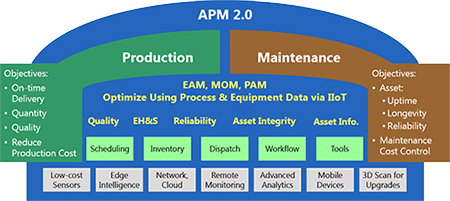Capital assets are long-lived, and costly for both initial acquisition and maintenance. ARC's research on Asset Performance Management (APM) concept provides a framework for organizations to analyze their asset management needs, develop effective maintenance strategies, and get the most return on assets (ROA).
 Asset Performance Management, or APM, has become a popular catchphrase for a variety of functions that help asset-intensive organizations get the most value out of their costly equipment investments. Unfortunately, it is rare to find two cases where Asset Performance Management means the same thing which makes it difficult to compare and evaluate solutions. ARC's new model for Asset Performance Management resolves this problem by clearly establishing the scope of APM. This includes defining the key processes that must be managed, associated stakeholders, and outlining the landscape that effective APM software solutions address.
Asset Performance Management, or APM, has become a popular catchphrase for a variety of functions that help asset-intensive organizations get the most value out of their costly equipment investments. Unfortunately, it is rare to find two cases where Asset Performance Management means the same thing which makes it difficult to compare and evaluate solutions. ARC's new model for Asset Performance Management resolves this problem by clearly establishing the scope of APM. This includes defining the key processes that must be managed, associated stakeholders, and outlining the landscape that effective APM software solutions address.
Asset Performance Management Software solutions vary in both their performance focus and the kinds of activities they support. Some view performance as a utilization issue and focus on ways that the organization can produce more and/or better products. Others view performance as an availability issue and focus on things that enhance maintenance efficiency, increase reliability, or extend asset life. Still others combine these performance perspectives, but their capabilities are limited to specific functional areas, technologies, and industries.
Asset Performance Management (APM) 2.0 is Evolving
ARC's model for Asset Performance Management has the broad view that combines utilization and availability perspectives. With Industrial IoT and Industry 4.0, the next generation - APM 2.0 – is currently evolving. ARC’s model encompasses the impact of IIoT on operations and maintenance activities, as well as their interdependencies. It also recognizes the need for organizations to manage their hidden assets - people and information. This APM 2.0 approach is firmly grounded in the extensive research ARC has done in Asset Lifecycle Management (ALM), enabling organizations to balance APM goals with other critical ALM objectives.
Asset performance has many dimensions including financial, health & safety, environmental, and sustainability. Achieving these goals requires a collaborative effort by all groups involved in the use and care of the facility to manage the interdependencies that constrain performance. To do this, they need an asset information management system that can deliver complete, accurate, and timely information to APM software workflows and enable seamless sharing of information across all APM stakeholders, internal or external to the organization.
ARC’s APM 2.0 concept provides thought leadership in that it explicitly recognizes Asset Information Management (AIM) as a key APM process. Research repeatedly shows that asset-intensive organizations suffer staggering losses each year because of poor asset information management. Neglect in this area has also been linked to major safety and compliance violations that have seriously blemished corporate reputations. Asset information management issues plague every group. Its role as the foundation for operational and maintenance excellence is clearly highlighted in the ARC model for APM 2.0.
How Can ARC Help?
ARC's analysts can help you analyze your current asset performance and identify the best opportunities for improvement. They can also educate you on technologies and best practices that you can use to improve your performance and help you select the solutions that are most suitable for your company.
Functioning as members of your own internal Asset Performance Management team, ARC's analysts can add our unique knowledge of technologies, suppliers and other APM programs to accelerate your continuous improvement efforts.
